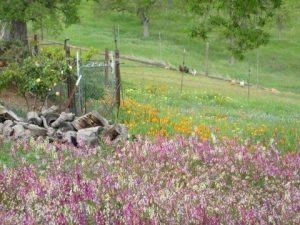About this time of the year, most gardeners have had it with watering, critter control, and zucchini excess. We anticipate a cup of tea in the cool of the morning accompanied by a little ‘virtual gardening’ (perusing a good horticultural magazine). Too bad! Now is the best time of the year to plant natives and perennials.
With the shortening of days, cooling of nights and return of moisture (hopefully!) to the air and first fall rains, the growing season begins. This isn’t obvious because it begins in the soil at the roots of the plant. With the rains, or an assist from the garden hose, native plants awaken from their summer dormancy, where survival depended on their ability to shut down, conserve energy and moisture, and hang on. Even though days will be cooling, the soil is a massive reservoir of heat, and as soon as a plant’s roots have moisture, they begin to grow.
In June, with its long days and introduction to summer’s daunting heat, most native plants are well on their way to ensure their species’ survival through seed. The flower was just the bribe, the come-on to the pollinator. With seed successfully set, the annual dies and the perennial or shrub rests.
It is interesting to observe how native plants prepare for that period of summer dormancy. Some shed a portion of their leaves—both because there is less work that needs to be done once active growth, flowering and seed set is accomplished, and to conserve moisture. Remaining leaves exhibit defensive strategies by toughening up, whitening to reflect sunlight and concentrating their resins and oils to protect themselves from browsing. This is also how native and Mediterranean plants survive decimation by Bambis and their like. We need to recognize this and allow our own gardens to slow down and toughen up for summer.
As fall approaches, a variety of California wild lilacs (Ceanothus), from the tall arching ‘Frosty Blue’ to the tough spreading groundcover ‘Anchor Bay’ are good choices to plant. Deer-proof manzanitas, spice bush (Calycanthus), fragrant wild mock orange (Philadelphus) and deer-resistant desert willow with either pink or burgundy blooms will enhance any garden. Trees, like the showy western redbud, the Modoc Cypress and incense cedar are great additions to a Motherlode garden.
Other drought-tolerant selections that are appropriate to the Foothill garden —like the native coral bells (Heuchera), ruby and sulfur buckwheats, and the exceptional Salvia ‘Bee’s Bliss’ which forms a dense mat with a four-foot spread and lavender blooms, are lovely choices for the garden.
Fall is the only time to successfully plant touchy natives like the Matilija poppy (Romneya), and Fremontodendron, which succumb to root rot if watered in the heat of the summer. By planting them in the fall they will be adequately established by next season.
So, that cup of tea will have to wait until all the fall planting has been done. After all the plants are in the ground, there will be time to sit, sip and wait for those wished-for rains that the forecasters predict will come with El Niño this autumn. If you would like to see some mature native plants in the garden, please attend the next U.C.C.E. Master Gardener Open Garden Day on Sunday, September 13th at 251 South Barretta Str., Sonora. The Demonstration Garden is open from 10:00 am to 1:00 pm and presentations start at 10:30 am.
Mary Anderson was a University of California Cooperative Extension Master Gardener of Tuolumne County. (Edited and updated by Francie McGowan)


